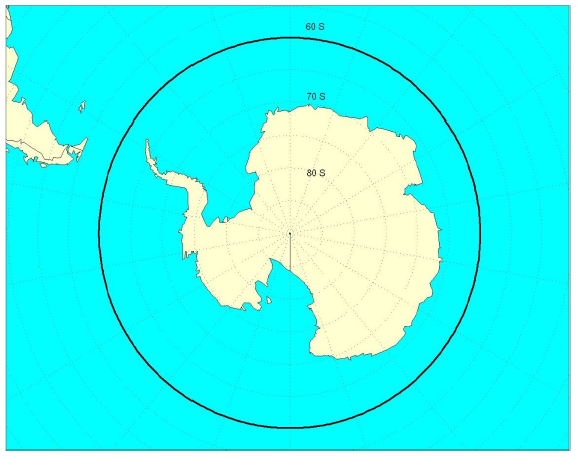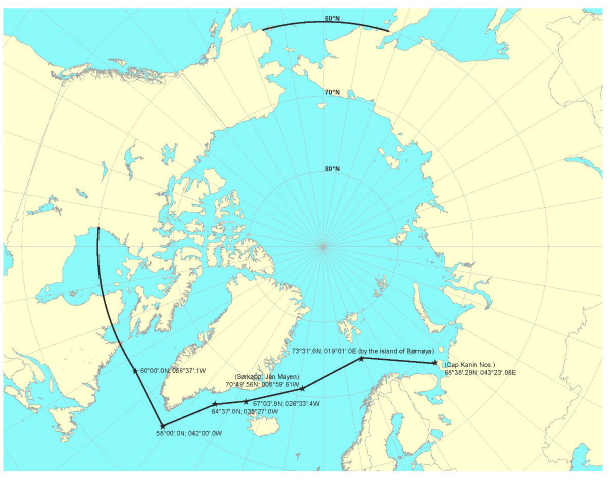1 Goal
The goal of this Code is to provide for safe ship operation and the protection of the
polar environment by addressing risks present in polar waters and not adequately
mitigated by other instruments of the Organization.
2 Definitions
For the purpose of this Code, the terms used have the meanings defined in the
following paragraphs. Terms used in part I-A, but not defined in this section shall
have the same meaning as defined in SOLAS. Terms used in part II-A, but not defined
in this section shall have the same meaning as defined in article 2 of MARPOL and
the relevant MARPOL Annexes.
2.1
Category A ship means a ship designed for operation in polar waters in at
least medium first-year ice, which may include old ice inclusions.
2.2
Category B ship means a ship not included in category A, designed for
operation in polar waters in at least thin first-year ice, which may include old ice
inclusions.
2.3
Category C ship means a ship designed to operate in open water or in ice
conditions less severe than those included in categories A and B.
2.4 First-year ice means sea ice of
not more than one winter growth developing from young ice with thickness from 0.3 m
to 2.0 m1footnote.
2.5
Ice free waters means no ice present. If ice of any kind is present this term
shall not be usedfootnote.
2.6
Ice of land origin means ice formed on land or in an ice shelf, found
floating in waterfootnote.
2.7
MARPOL means the International Convention for the Prevention of Pollution
from Ships, 1973, as modified by the 1978 Protocol relating thereto (MARPOL), as
amended.
2.8
Medium first-year ice means first-year ice of 70 cm to 120 cm thickness.footnote
2.9
Old ice means sea ice which has survived at least one summer's melt; typical
thickness up to 3 m or more. It is subdivided into residual first-year ice,
second-year ice and multi-year icefootnote.
2.10 Open water means a large area of
freely navigable water in which sea ice is present in concentrations less than 1/10.
No ice of land origin is presentfootnote.
2.11
Organization means the International Maritime Organization.
2.12 Sea ice means any form of ice
found at sea which has originated from the freezing of sea waterfootnote.
2.13
SOLAS means the International Convention for the Safety of Life at Sea, 1974,
as amended.
2.14
STCW Convention means the International Convention on Standards of Training,
Certification and Watchkeeping for Seafarers, 1978, as amended.
2.15
Thin first-year ice means first-year ice 30 cm to 70 cm thick.
3 Sources of hazards
3.1 The Polar Code considers hazards which
may lead to elevated levels of risk due to increased probability of occurrence, more
severe consequences, or both:
- .1 Ice, as it may affect hull
structure, stability characteristics, machinery systems, navigation, the
outdoor working environment, maintenance and emergency preparedness tasks
and malfunction of safety equipment and systems;
- .2 experiencing topside icing,
with potential reduction of stability and equipment functionality;
- .3 low temperature, as it affects
the working environment and human performance, maintenance and emergency
preparedness tasks, material properties and equipment efficiency, survival
time and performance of safety equipment and systems;
- .4 extended periods of darkness or
daylight as it may affect navigation and human performance;
- .5 high latitude, as it affects
navigation systems, communication systems and the quality of ice imagery
information;
- .6 remoteness and possible lack of
accurate and complete hydrographic data and information, reduced
availability of navigational aids and seamarks with increased potential for
groundings compounded by remoteness, limited readily deployable SAR
facilities, delays in emergency response and limited communications
capability, with the potential to affect incident response;
- .7 potential lack of ship crew
experience in polar operations, with potential for human error;
- .8 potential lack of suitable
emergency response equipment, with the potential for limiting the
effectiveness of mitigation measures;
- .9 rapidly changing and severe
weather conditions, with the potential for escalation of incidents; and
- .10 the environment with respect to
sensitivity to harmful substances and other environmental impacts and its
need for longer restoration.
3.2 The risk level within polar waters may
differ depending on the geographical location, time of the year with respect to
daylight, ice-coverage, etc. Thus, the mitigating measures required to address the
above specific hazards may vary within polar waters and may be different in Arctic
and Antarctic waters.
4 Structure of the Code
This Code consists of Introduction, parts I and II. The Introduction contains
mandatory provisions applicable to both parts I and II. Part I is subdivided into
part I-A, which contains mandatory provisions on safety measures, and part I-B
containing recommendations on safety. Part II is subdivided into part II-A, which
contains mandatory provisions on pollution prevention, and part II-B containing
recommendations on pollution prevention.
5 Figures illustrating the Antarctic area
and Arctic waters, as defined in SOLAS regulations XIV/1.2 and XIV/1.3,
respectively, and MARPOL Annex I, regulations 11.46.2; Annex II, regulations
10.21.2; Annex IV, regulation 7.17.3; and Annex V, regulation 3.13.2

Figure 1 – Maximum extent
of Antarctic area applicationfootnote

Figure 2 – Maximum extent
of Arctic waters applicationfootnote